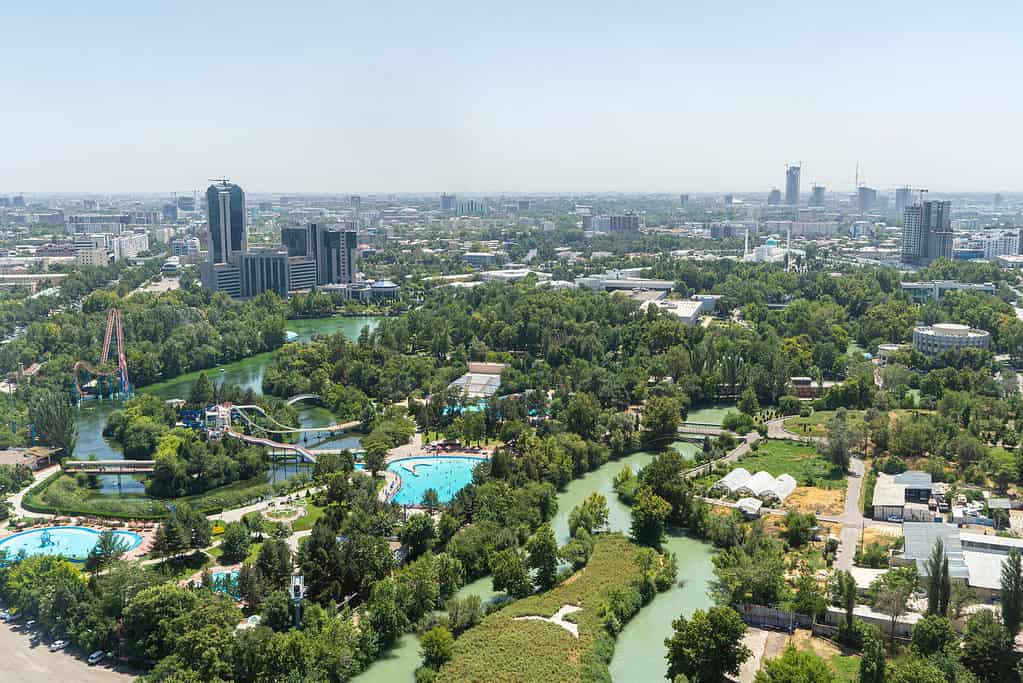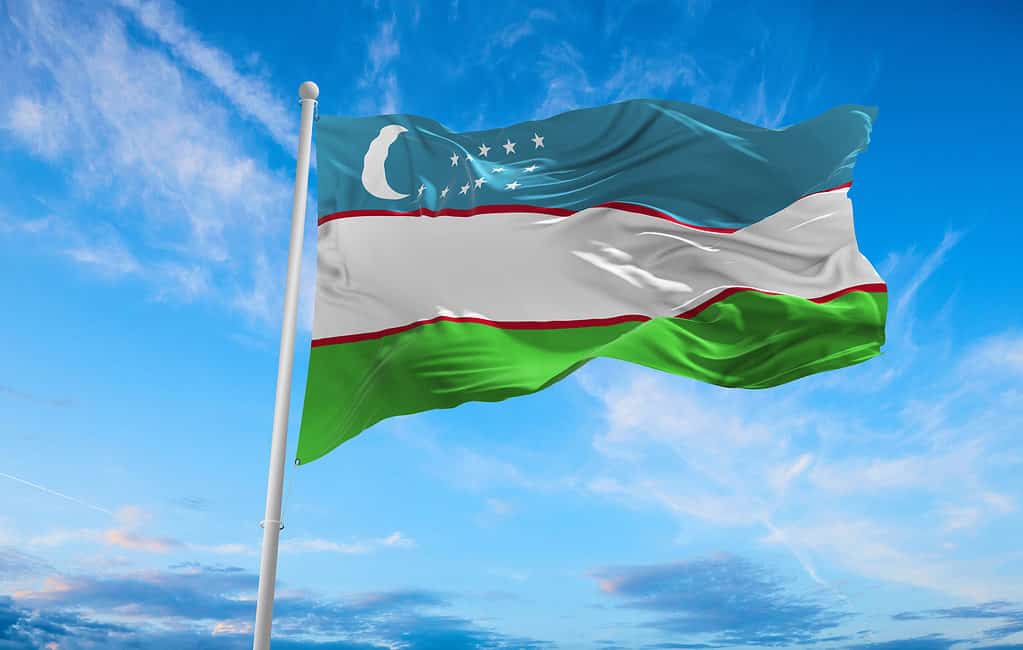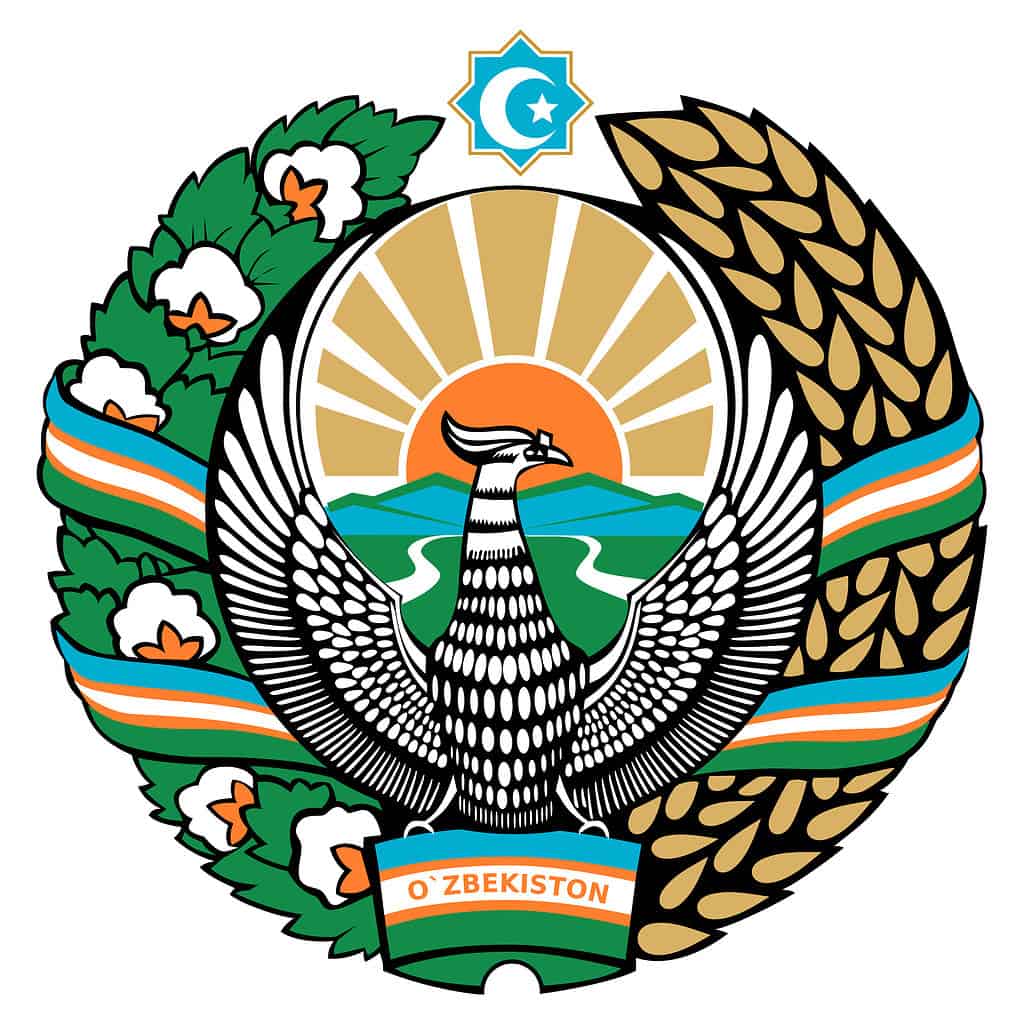Uzbekistan is a landlocked country, 172,700 square miles in size, located in Central Asia. The largest city in Uzbekistan is Tashkent, which is the capital city. Uzbekistan is part of the Turkic world, and the language spoken throughout the country is Uzbek, but you will also hear Russian and Tajik in some regions. The main religion is Muslim.
Uzbekistan is pronounced [ozbekiˈstɒn]. The climate in this country is hot and dry, with less than eight inches of rain per year. Summer temperatures reach a high of 104°F, and winters are around -9°F.
Uzbeks make up the largest Turkic group outside of Turkey, with over 16 million Uzbeks living in Uzbekistan. Uzbeks are descendants of the Mongol Golden Horde from the 15th and 16th centuries. The name Uzbek is believed to be from the Mongol khan named Öz Beg. Uzbekistan people have a rich history and are a diverse group of people.

Tashkent is the capital and largest city of Uzbekistan.
©Yernar Almabek/Shutterstock.com
Flag of Uzbekistan: Creation
Soon after the Soviet Union dissolved, the search for a new flag began. A contest was announced to determine the new design. Two hundred people entered submissions, and a panel of judges decided the winner. The winning design was adopted on November 18th, 1991, making Uzbekistan the first of the republics in Central Asia to choose their new flag. The flag was designed to represent the new freedom of the people, as well as their hope for the future. It contains many symbolic features, which we will describe in detail below. Uzbekistan also has a state emblem that beautifully depicts its ideals.
The Flag of Uzbekistan: Description
The flag of Uzbekistan is made up of three horizontal bands. The top band is blue and contains a crescent moon and twelve stars in the left corner. The middle band is pure white-edged with thin red stripes. The lower band is bright green. This flag was adopted in 1991 after the Republic of Uzbekistan gained independence.
The horizontal stripes of blue, white, and green bear some similarity to the flags of two other countries; Lesotho in South Africa and Puntland in Somalia.
The Flag of Uzbekistan: Symbolism
As with most flags, the flag of Uzbekistan is rich in symbolism and represents the country well. The top band of blue on the flag is meant to symbolize a blue sky and fresh, clear water. Azure blue also symbolizes the Turkic people.
The blue band shows the birth of a new moon, a symbol of the birth of a new nation, and a historical image depicting Islam. The stars represent divinity and are arranged on the flag to spell out the word Allah in Arabic. The stars also hint at the 12 months of the traditional Uzbek calendar as well the pursuit of happiness by the Uzbek people.
The white middle band stands for peace and good luck, while the red filament surrounding the white stands for the power of life. The bottom green band represents new life, nature, and a plentiful harvest.

The flag of Uzbekistan includes an image of a moon, a symbol of the birth of a new nation, as well as stars representing divinity.
©Maxim Studio/Shutterstock.com
Emblem of Uzbekistan: Description
The state emblem of Uzbekistan started in 1992 to represent the new Republic of Uzbekistan. The emblem is a coat of arms meant to display the country’s wealth.
On the left of the emblem, a cotton plant is displayed. On the right side, a wreath made of wheat is shown. These two images are intertwined with a ribbon in the same colors as the flag of Uzbekistan (blue, white, and green). At the top center is an Islamic star containing a crescent moon and a small white star. In the center of the emblem is a huma (a mythical bird of Iranian legend) facing right with wings outstretched. The huma’s wings encircle green pastures, two rivers, a mountain range, and the rising sun. The bird’s feet are resting on a banner in the national colors with the word Uzbekistan in Latin – Oʻzbekiston.
Emblem of Uzbekistan: Symbolism
There are many symbolic images depicted in the emblem of Uzbekistan. The huma bird with open wings is a symbol of happiness and freedom. Uzbek poets have described the huma as the kindest creature ever to exist. The star of Islam is a sacred religious symbol of divinity. The sun shows a light that will shine on the path, and green pastures hint at abundant harvests and favorable weather. The two rivers flowing through the valley represent the Amu-Darya and Syr-Darya rivers that flow through Uzbekistan. Wheat symbolizes wealth and prosperity, as does cotton, a vital industry in the country. The wheat and cotton are intertwined with a ribbon of the state flag, representing unity and peace amount the people.

The emblem of Uzbekistan contains many symbolic images representing happiness, freedom, peace, prosperity and union.
©Atlaspix/Shutterstock.com
Previous Flags of Uzbekistan
Before the dissolution of the Soviet Union, the country that we now know as Uzbekistan was called the Uzbek Soviet Socialist Republic. They have a long history of different flags. There were three main versions (which we will list below) and many tiny revisions in between.
- 1925. The first flag was adopted on July 22nd, 1925. It was scarlet red, with the country’s name written in Arabic. The characters Y3CCP were displayed in Cyrillic script in the top left corner of the flag in gold lettering.
- 1937. The second version of the flag was adopted on February 14th, 1937. The flag was the same panel of red except for one detail. In the top left corner, golden letters spell out Ozbekistan SSR in Uzbek. Below that are the letters Y3.C.C.P in Russian.
- 1952. On August 29th, 1952, the third version of the flag was adopted. It was a panel of red with a horizontal blue strip running down the middle, bordered by a thin white stripe. A golden sickle and hammer are displayed in the top left corner. Above that is a five-point star framed in gold.
Uzbekistan: Other Flags
- The flag of Karakalpakstan represents the autonomous republic that occupies the northwestern part of Uzbekistan. Their flag is three horizontal bands of blue, yellow, and green separated by white and red borders. In the top left corner stands a crescent moon and five white stars.
- Presidential standard of Uzbekistan. This flag shows the emblem of Uzbekistan superimposed over the middle of the flag of Uzbekistan.
- The flag of the State Security Service of Uzbekistan. This flag is a pure blue background with a shield of protection in the center. Inside the shield, the emblem of Uzbekistan is displayed, bordered by the national colors of blue, white, and green.
- The flag of the Ministry of Defense. This flag is a blue border with a golden circle in the middle. Inside the ring is a golden star with a horse and rider in the middle of the star.
- The flag of the Uzbekistan Air and Air Defence Forces. This flag shows a small green circle directly in the middle, surrounded by a band of white and bordered by a thin red filament. Alternating out from the center circle are stripes of bright yellow and blue in a mesmerizing pattern.
- The flag of the Uzbekistan Naval Forces. This flag is bright green with a rectangle of white in the upper left corner. The white rectangle has a stripe of blue across the bottom. Inside the white rectangle is an anchor with a rope intertwined around it, a crescent moon, and twelve stars, all in red.
Up Next
- The Flag of Liberia: History, Meaning, and Symbolism
- Animals in Uzbekistan
- The Flag of Lesotho: History, Meaning, and Symbolism
The photo featured at the top of this post is © iStock.com/Ivan Burchak
Sources
- World Atlas, Available here: https://www.worldatlas.com/amp/flags/uzbekistan
- Legislative Chamber of the Oliy Majlis of Republic of Uzbekistanep, Available here: https://parliament.gov.uz/en/flag/
- Facts and Details, Available here: https://factsanddetails.com/central-asia/Uzbekistan/sub8_3d/entry-4697.html#:~:text=Uzbeks%20are%20the%20largest%20Turkic,the%2015th%20and%2016th%20century
- De Gruyter, Available here: https://www.degruyter.com/document/doi/10.1515/9780822387046-004/html?lang=de
- Google Scholar, Available here: https://www.google-scholar.com/index.php/tajssei/article/view/60
Thank you for reading! Have some feedback for us? Contact the AZ Animals editorial team.






